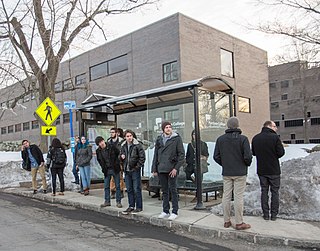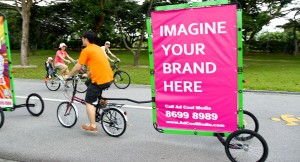
Transit media is a form of out-of-home advertising that displays advertisements in or on the outside of vehicles, such as on the side of or above the seats of a bus or tram. [1]

Transit media is a form of out-of-home advertising that displays advertisements in or on the outside of vehicles, such as on the side of or above the seats of a bus or tram. [1]
Transit media used to consist of paper or paint, but LED panels may be used, allowing advertisements to be rotated or scheduled by GPS location, enabling advertisers to target specific audiences. [2] The medium offers a balance between traditional billboards and smaller, more mobile signage. [3] For example, an individually branded car might be casually driven around a city for the majority of the time, but can occasionally be integrated into a multi-vehicle convoy or parked arrangement suitable for promotional activities.

Advertising is the practice and techniques employed to bring attention to a product or service. Advertising aims to present a product or service in terms of utility, advantages and qualities of interest to consumers. It is typically used to promote a specific good or service, but there are a wide range of uses, the most common being commercial advertisement.

A bus is a motor vehicle that carries significantly more passengers than an average car or van, but fewer than the average rail transport. It is most commonly used in public transport, but is also in use for charter purposes, or through private ownership. Although the average bus carries between 30 and 100 passengers, some buses have a capacity of up to 300 passengers. The most common type is the single-deck rigid bus, with double-decker and articulated buses carrying larger loads, and midibuses and minibuses carrying smaller loads. Coaches are used for longer-distance services. Many types of buses, such as city transit buses and inter-city coaches, charge a fare. Other types, such as elementary or secondary school buses or shuttle buses within a post-secondary education campus, are free. In many jurisdictions, bus drivers require a special large vehicle licence above and beyond a regular driving license.

A bus stop is a place where buses stop for passengers to get on and off the bus. The construction of bus stops tends to reflect the level of usage, where stops at busy locations may have shelters, seating, and possibly electronic passenger information systems; less busy stops may use a simple pole and flag to mark the location. Bus stops are, in some locations, clustered together into transport hubs allowing interchange between routes from nearby stops and with other public transport modes to maximise convenience.

A billboard is a large outdoor advertising structure, typically found in high-traffic areas such as alongside busy roads. Billboards present large advertisements to passing pedestrians and drivers. Typically brands use billboards to build their brands or to push for their new products.

RoadShow is the first "Multi-Media on-Board" (MMOB) service system on transit vehicles in Hong Kong. It was launched by The Kowloon Motor Bus Holdings Limited in December 2000. The MMOB business was taken over by RoadShow Holdings Limited in 2001 prior to its listing on the Stock Exchange.

In bus advertising, buses and their related infrastructure is a medium commonly used by advertisers to reach the public with their message. Usually, this takes the form of promoting commercial brands, but can also be used for public campaign messages. Buses may also be used as part of a political or promotional campaign, or as a tool in a commercial enterprise.

An articulated bus, also referred to as a slinky bus, bendy bus, tandem bus, vestibule bus, stretch bus, or an accordion bus, is an articulated vehicle, typically a motor bus or trolleybus, used in public transportation. It is usually a single-decker, and comprises two or more rigid sections linked by a pivoting joint (articulation) enclosed by protective bellows inside and outside and a cover plate on the floor. This allows a longer legal length than rigid-bodied buses, and hence a higher passenger capacity (94–120), while still allowing the bus to maneuver adequately.

Outdoor advertising or out-of-home (OOH) advertising includes public billboards, wallscapes, and posters seen while "on the go". OOH advertising formats fall into four main categories: billboards, street furniture, transit, and alternative.

JCDecaux Group is a multinational corporation focused on outdoor advertising. As of 2016, it is the largest company in its sector worldwide with adverts on 140.000 bus stops and 145 airports. The company is headquartered in Neuilly-sur-Seine, near Paris, France.
Pattison Outdoor Advertising is a Canadian out-of-home advertising company owned by the Jim Pattison Group. According to the Canadian Out-of-Home Measurement Bureau, it was Canada's largest out-of-home advertising company in 2013, holding more than 55% of the national market share in horizontal posters and a 43% market share of all traditional out-of-home media.
Outfront Media, Inc. is one of the largest outdoor media companies. It operates in markets including the United States and Canada. The Americas division is led by chief executive officer Jeremy Male. Outfront Media operates both billboards and transit displays.

A mobile billboard, also known as a "digital billboard truck", is a device used for advertising on the sides of a truck or trailer that is typically mobile. Mobile billboards are a form of transit media; static billboards, and mall/airport advertising fall into this same category. Using a mobile billboard for advertising is an advertising niche called mobile outdoor advertising.

MediaCorp TV TVMobile was a subsidiary of MediaCorp Singapore and was the first channel in the world to pioneer the use of Digital Video Broadcast (DVB) technology to deliver television programmes to commuters. Operating on 89.3 MHz, TVMobile provided the latest infotainment, entertainment programmes, and real-time news, keeping travellers informed while on the move.
News Outdoor Group was at the largest outdoor advertising company in Eastern Europe, a subsidiary of News Corp. NewsCorp entered the OOH advertising market in 1999 and NOG has since become the leading emerging market OOH advertising company in the world. NOG has more than 4,500 employees and operates approximately 60,000 advertising displays in more than 300 cities spread across 13 time zones. Its biggest city - and company headquarters - was Moscow, Russia.
Advertising research is a systematic process of marketing research conducted to improve the efficiency of advertising. Advertising research is a detailed study conducted to know how customers respond to a particular ad or advertising campaign.
The term fleet media refers to the placement of advertisements on the side of trucks, vans, and other forms of transportation that form part of a commercial fleet. It entails more than the addition of a company logo, name and number to the vehicles belonging to that company. The crucial difference is that fleet media, like any other form of advertising, is commercially available. If it is possible to buy space on a retailer’s delivery fleet then this would be fleet media as a form of retail media. Equally if a delivery/logistics company were to sell advertising space on its delivery vans this would be fleet media.
Electronic signage are illuminant advertising media in the signage industry. Major electronic signage include fluorescent signs, HID, incandescent signs, LED signs, and neon signs. Besides, LED signs and HID are so-called digital signage.

A truckside advertisement or truckside ad is a billboard that is affixed to a truck that is for the purpose of advertising to the general public. This is a form of outdoor advertising classified as transit advertising by the outdoor advertising association of America.

A vehicle vinyl wrap is the automotive aftermarket practice of completely or partially covering a vehicle's original paint with a vinyl wrap. Generally this vinyl wrap will be a different color or finish like a gloss, matte, chrome or clear protective layer.

The Outdoor Circle is a nonprofit organization in Hawaii focused on conservationism. The organization was founded in 1912 by a group of seven women including Cherilla Storrs Lowrey with the goal of beautifying Honolulu and opposing the use of billboards in Hawaii; members almost immediately began planting trees with the organization after its establishment, leading the program director to estimate in 2020 that the Circle had planted "tens of thousands of trees" across the state.